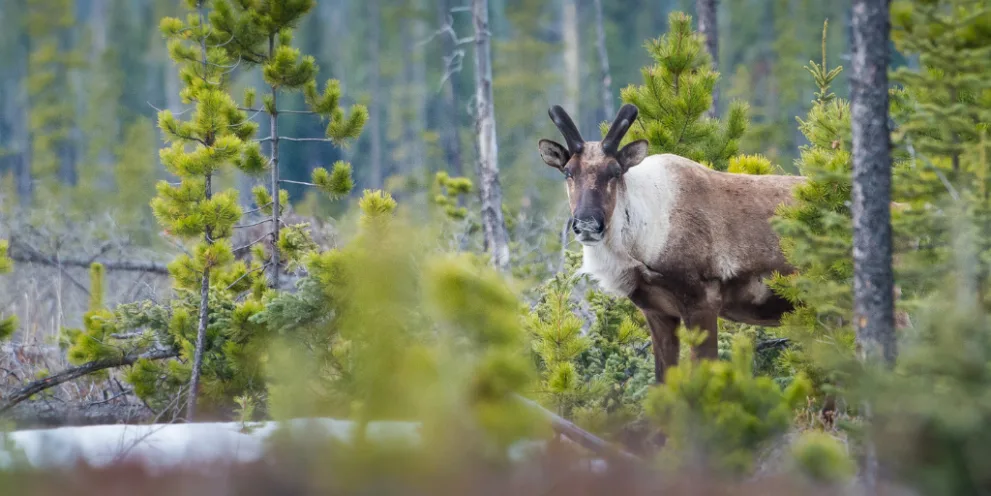Boreal Caribou—also known as Forest-dwelling Caribou in Quebec—are an iconic Canadian species that is intimately connected to the culture, history, and traditions of Indigenous peoples. Formerly abundant, the population in Canada is now estimated to be less than 34,000 individuals. According to data, the species is declining in many parts of the country. Boreal Caribou have been listed as threatened in Canada since 2003, meaning the species could become extinct if nothing is done to protect it.
Implementation of an emergency order in Quebec
While the provinces and territories have primary responsibility for managing land and wildlife within their jurisdictions, the Species at Risk Act includes provisions designed to protect species at risk and their habitats on non-federal lands. This is particularly the case of section 80, which stipulates that the Minister of Environment and Climate Change has an obligation to recommend to the Governor in Council that an emergency order be made if the Minister is of the opinion that a species faces imminent threats to its survival or recovery.
At the recommendation of the Minister of Environment and Climate Change, the Government of Canada is taking steps to make an emergency order to address the imminent threats faced by the three most at-risk Boreal Caribou populations in Quebec, namely those in Val-d’Or, Charlevoix, and Pipmuacan. The populations in Val-d’Or and Charlevoix, with 9 and 30 individuals, respectively, live in enclosures year-round. The population in Val-d’Or has already crossed the threshold of quasi-extinction, and the one in Charlevoix is very close to reaching it. With less than 300 individuals, the Pipmuacan population could cross the threshold in around 10 years.
In the coming weeks, the Government of Canada will consult with the Government of Quebec, Quebec’s Indigenous communities, the public, stakeholders, and interested parties, including local communities and industries, on the scope of potential protection areas and proposed prohibitions that would apply in these areas. Following the consultations, the order will be finalized. The order is a regulation that, once approved by the Governor in Council, will protect targeted areas of best available habitat on Quebec provincial lands for the Val-d’Or, Charlevoix, and Pipmuacan populations. The imminent threats to recovery are due to the increase in the scope of disturbance from multiple threats, in particular the impact of logging for industrial activities and road network expansions. The order will prohibit activities that contribute to these imminent threats. Under the Species at Risk Act, if Quebec were to implement concrete protection measures leading the Minister to conclude that the species was no longer facing imminent threats to its recovery, the Governor in Council could, at the Minister’s recommendation, withdraw the order.
The tabling of the Quebec strategy for Boreal and Mountain Caribou has been postponed repeatedly in recent years. Although two pilot projects were recently announced, the Government of Quebec has not submitted a comprehensive strategy, and the species continues to face imminent threats to its recovery.
Boreal Caribou in Quebec and Canada
With approximately 15 percent of Canada’s Boreal Caribou population, Quebec plays a major role in the species’ recovery. In 2023, the Quebec government estimated the Boreal Caribou population to be between 6,162 and 7,445 individuals. The majority of Quebec’s populations are declining, one of the main reasons being the loss or alteration of caribou habitat.
An important species to the boreal forest
Boreal Caribou are an important part of the boreal forest ecosystem. Boreal Caribou tend to avoid disturbed areas, and thus their movement pattern and population status can help us understand more about the overall health of the boreal forest. Protecting the species’ habitat can have significant co-benefits for other species at risk, plants and wildlife, and biodiversity in general. For example, protecting Boreal Caribou habitat across Canada could improve outcomes for 90 percent of the bird and mammal species that live in the boreal forest, and protect soil carbon storage hotspots.
Threats
Boreal Caribou populations have declined significantly across Canada over the last few decades. This is due in large part to increased predation linked to human-caused habitat disturbance. Caribou need large patches of mature and old-growth forests. Older forests allow caribou to separate themselves from their predators. Habitat disturbances include use of land by industry such as forestry, mining, oil and gas development, and “linear features” like roads. There are also natural disturbances to Boreal Caribou habitat, such as forest fires and insect outbreaks. Natural and human disturbances can lead to younger stands of trees, which tend to attract other prey such as moose and deer. These animals can carry diseases that threaten Boreal Caribou and can also increase the number of predators, such as bears and wolves, in caribou habitat. Disturbed habitats, including multi-use roads, can make it easier for predators to travel through caribou habitat, increasing the chances that predators encounter caribou.
Climate change may also have long-term effects on Boreal Caribou. The effects of climate change are expected to increase the impacts of natural and human disturbances on Boreal Caribou and their habitat. Like disturbances, less severe winters and increasing proportions of hardwood trees in the southern portions of the boreal forest could increase the abundance of deer, moose, and predators in the North, thus contributing to the decline of Boreal Caribou distribution. In addition, warmer and drier conditions are expected to increase the frequency and magnitude of fires in Canada’s boreal forest, adding to overall disturbance levels.








